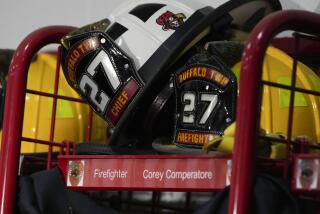Race Riot Murder Trial Begins
- Share via
YORK, Pa. — Dredging up caustic memories of an unsolved killing and urban riots that eroded race relations in this historic town, the city’s former mayor went on trial Tuesday for murder, accused of inciting “a frenzy” that led to the 1969 ambush of a black woman by white street gang members.
Prosecutors said former York mayor and police officer Charlie Robertson provided ammunition and encouragement to gang members accused of firing on Lillie Belle Allen, a South Carolina woman whose slaying has stymied law enforcement officials for 33 years.
“These defendants let slip the dogs of war,” said York County prosecutor Thomas H. Kelley, pointing at Robertson, 67, and his fellow defendants, Robert Messer- smith and Gregory Neff.
Prosecutors acknowledged that Robertson did not participate directly in the slaying, but all three men are charged with first- and second-degree murder and acting as accessories. Robertson is accused of handing out bullets to gang members and inciting them to kill by shouting racist slogans during an angry public rally.
Defense attorneys countered that dozens of young toughs known as the “Newberry Street boys” mistakenly shot at a car driven by Allen’s aunt because York had been ravaged by five days of riots and overwhelmed police had urged them to arm themselves. Robertson’s lawyer added that previous investigations of Allen’s murder had never cited his involvement and no evidence of it exists now.
“Charlie Robertson isn’t going to come out of this as a murderer,” said attorney William C. Costopolous.
In York, a central Pennsylvania town of 41,000 that once housed the Continental Congress, the Allen trial has balkanized older white and black residents unable to let go of old animosities and baffled newcomers who are slowly altering the area’s demographics.
On Tuesday night, York’s City Council approved a nonbinding resolution urging the Justice Department to open a civil rights investigation into the Police Department’s handling of Allen’s slaying. The federal agency has repeatedly rejected a role in the case, but York officials hoped the trial will finally prod its involvement. The court proceedings are expected to last up to six weeks.
“There’s still too much mistrust on both sides that can only be dealt with by confronting this issue head-on,” said Joseph R. Musso, the council’s vice president and a supporter of federal intervention.
During opening arguments and the first day’s testimony, lawyers and witnesses portrayed a city simmering with racial hatred that exploded on July 17, 1969, after a black youth burned in an accident falsely accused white gang members of setting him afire.
Residents who lived near the scene of Allen’s slaying at a railroad crossing on Newberry Street recalled defiant, gun-wielding white youths standing on porches and hiding in railroad cars to confront black intruders.
Their attitude, said one witness, Steve Noonan, was “ ‘This is our neighborhood and we’re gonna protect it. We don’t want blacks in here.’ It was kind of ugly.”
Allen’s aunt, Hattie Dixon, who survived the shooting, choked back tears as she was overwhelmed by vivid memories of panic and confusion. Frozen in fear in the driver’s seat, Dixon recalled seeing Allen gunned down outside the car as the younger woman tried to take the wheel.
“I was so afraid. I felt like I was looking death in the face,” Dixon said. She and other prosecution witnesses testified that the shooting started even before Allen emerged from the car.
But defense lawyers insisted that other witnesses saw gunfire erupt only after Allen left the vehicle.
Dixon and neighborhood residents also testified that a police roadblock did nothing to stop her from driving through the white enclave in a car with Allen and Dixon’s husband and parents.
Unlike Allen, the others escaped unharmed by slumping down in their seats. The car, a white Cadillac, was riddled with bullet holes and dents, Dixon testified.
Allen’s killing was a tragic mistake, defense lawyers argued--set off by the appearance of a similar white Cadillac hours earlier in the area. A black man who drove the other Cadillac had threatened Messersmith with violence if his parents were harmed--a vow that spurred Messersmith, Neff and dozens of other youths to arm themselves, lawyers said.
Defense lawyers signaled they would argue their clients had no choice but to protect themselves with guns--a choice they said was sanctioned under state law justifying the use of force by private citizens in extreme situations.
Residents of Newberry Street hoarded rifles, shotguns and pistols the day after hundreds of whites gathered at a rally in a nearby park. They came worried about worsening riots and angry about the fatal shooting of a York police officer during the disturbance.
During the outdoor meeting, Robertson and other York police officers told the youths they were “outmanned and outgunned. ‘You have to protect yourselves. Go out and draw a line on Newberry Street, that’s the best you can do,’ ” said Peter Solymos, a lawyer for Messersmith.
But prosecutors charge that Robertson stepped over the line that day in his capacity as a law enforcement official, shouting “white power” and providing ammunition to at least one of the assailants. According to Kelley, the killers “were present at [Newberry] Street, whipped up in a frenzy by a number of police officers, including” Robertson.
Robertson has denied any culpability in Allen’s death, but conceded in earlier public statements that he had yelled “white power” during the rally.
After serving 29 years as a police officer, Robertson was elected mayor in 1994, serving two terms and preparing to run a third time this year when he was indicted after a three-year grand jury investigation launched by the district attorney’s office.
More to Read
Sign up for Essential California
The most important California stories and recommendations in your inbox every morning.
You may occasionally receive promotional content from the Los Angeles Times.










